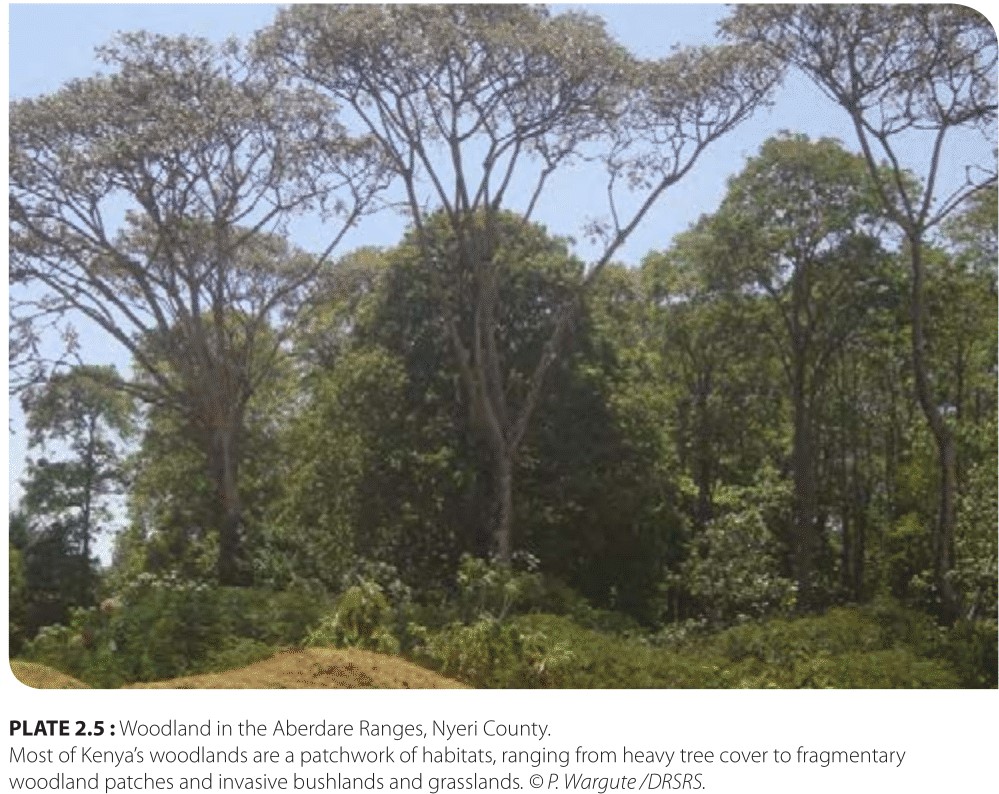Woodlands
The woodland ecosystems of Kenya cover some 15 per cent of the land surface lying along the rainfall and altitudinal gradient between moist forests and dry savannahs. Woodlands include trees of lower stature and more open canopy, allowing light to penetrate to the ground and support a rich understory vegetation. Woodlands cover a wide range of habitats, from the dry coastal Boni dwarf forest to upland savannahs, and riverine and ground-water woodlands. By far the most extensive woodlands fall within the moist coastal belt, around mountain bases and in the medium altitude uplands. Typical species of trees include Crotons and the larger Acacias —Terminalia, Combretum, and Brachystegia. Woodlands vary greatly in canopy cover due to local variations in topography, drainage and soils. Most woodlands have been heavily shaped and modified by large herbivores, including giraffe and elephants, which along with baboons are important agents of seed dispersal. Kenya’s woodlands have also been heavily influenced by human activity—livestock impact, shifting settlements and fires in pastoral regions, and clearance for farms and villages in the highlands and at the coast. Woodlands are nonetheless among the richest of Kenya’s ecosystems in terms of species, given that they are a bridging habitat between forest and savannahs and support a wide variety of species from wet and dry climates. Many of Kenya’s most important bird areas and some of its richest wildlife populations are found in woodlands and associated mixed habitats.

Importance of Woodlands
Woodlands, because of their extensive cover and high woody biomass, provide many ecological services. These include carbon capture, reducing surface heat, regulating water and nutrient cycles, and abating winds, floods and erosion. Woodlands support
a rich variety of animals and plants, bridging as they do wet and dry habitats. Woodlands also supply food, water, fuel, clothing, building materials and medicines to traditional communities, and feature prominently in culture, heritage and ceremonies. They support some of the largest and economically diversified rural populations in Kenya due to their interface between herders, farmers, hunter-gatherers and fishing communities. In recent decades woodlands have perhaps disappeared faster than any habitat in Kenya as a result of overharvesting for the fuelwood and charcoal that supply two-thirds of household energy countrywide. Woodlands are of growing importance to tourism and the recreation industry. Planted private and community woodlots are playing a growing role in providing farmers and herders with fuel, building materials, fodder, shade and windbreaks.
a rich variety of animals and plants, bridging as they do wet and dry habitats. Woodlands also supply food, water, fuel, clothing, building materials and medicines to traditional communities, and feature prominently in culture, heritage and ceremonies. They support some of the largest and economically diversified rural populations in Kenya due to their interface between herders, farmers, hunter-gatherers and fishing communities. In recent decades woodlands have perhaps disappeared faster than any habitat in Kenya as a result of overharvesting for the fuelwood and charcoal that supply two-thirds of household energy countrywide. Woodlands are of growing importance to tourism and the recreation industry. Planted private and community woodlots are playing a growing role in providing farmers and herders with fuel, building materials, fodder, shade and windbreaks.

